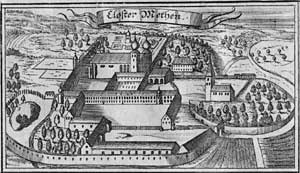Metten Abbey
Metten Abbey, or St. Michael's Abbey at Metten (in German Abtei Metten or Kloster Metten) is a house of the Benedictine Order in Metten near Deggendorf, situated between the fringes of the Bavarian Forest and the valley of the Danube, in Bavaria in Germany.
The abbey was founded in around 766[1] by Gamelbert of Michaelsbuch. For many centuries Metten was under the lordship of the Dukes and Electors of Bavaria. When Charlemagne stayed in Regensburg for three years after 788, Utto turned his abbey over to the Frankish ruler, making the Ducal Abbey a Royal Abbey. After the Carolingians became extinct, Metten was turned into an Imperial Abbey. Besides the work of land clearance in the Bavarian border territories, the monks were very active in education. Members of the abbey were not only schoolteachers, but also members of the Bavarian Academy of Science in Munich and professors of philosophy and theology in Freising and Salzburg. Gerhard, Bishop of Passau was abbot in the 10th century.
After secularisation in 1803 the abbey's property was confiscated, and by 1815 had all been auctioned off. Over a number of years Johann von Pronath acquired the greater part of the former premises and succeeded in persuading King Ludwig I of Bavaria in 1830 to re-establish the monastery, which by 1837 had been set up to incorporate a boarding school (Gymnasium), in continuance of its educational traditions, which the monastery has run to this day.
The re-founded abbey was very active in re-settling new monasteries. In 1846 Boniface Wimmer left from Metten to establish the Benedictines in the United States and founded Saint Vincent Archabbey in Latrobe, Pennsylvania.[2] Monks from Latrobe in turn founded Saint John's Abbey in Minnesota, and the adjoining Saint John's University.[3]Since 1858 Metten has been a member of the Bavarian Congregation of the Benedictine Confederation.
During World War II, more than 1,000 refugees from the East found shelter at Metten, located just 30 miles from the Czechoslovak border. "The last days of the war saw heavy fighting for the nearby bridges on the Danube, where SS troops held out against approaching U.S. forces. Elsewhere, an advance of combat forces was usually preceded by bombing, but none took place at Metten. Instead, American tank units spearheaded the attack, sparing the townspeople as well as the monastery from great destruction. Years later, the brothers at Metten learned that among the staff officers of the United States army unit that had marched into Metten were some who had studied at St. Vincent and St. John."[4]
Dom Edmund Beck, a monk of Metten, edited many of the Syriac works of Saint Ephrem the Syrian in the Corpus Scriptorum Christianorum Orientalium.

